The convergence of geopolitical and macroeconomic shocks – war in Europe, fractured energy markets, 40-year high inflation, interest rate hikes, depleted capital – as well as the second most expensive natural disaster ever (Hurricane Ian), has introduced significant volatility into the market.
According to Howden’s The Great Realignment Report, divergent rate momentum by class of business had been the recent norm as individual mini-cycles responded with varying levels of sensitivity to losses and broader macroeconomic factors.

Pricing cycles in the commercial insurance and reinsurance sectors are now converging, marked by price increase moderation overall for the former, albeit with strengthening in challenged areas, and rapid acceleration (dislocation even) for the latter.
Howden pricing index for primary, reinsurance and retrocession markets – 2012 to 2023

Reinsurance market
Mounting pressures in the reinsurance market, already evident during last year’s mid-year renewal cycle were exacerbated significantly by Hurricane Ian after it made landfall in Florida as a category 4 storm, reinforcing one of the hardest reinsurance markets in living memory (see 2023 Reinsurance Market Dynamics).
Demand-side pressures coincided with a severe capacity crunch, as capital providers pulled back whilst others were only willing to maintain allocations.
This was, in turn, driven by a significant impairment of dedicated reinsurance capital, which fell sharply as investment grade securities experienced their worst performance in over 40 years.
Historically, the sector’s gearing to high grade, short-to-medium duration securities has bolstered its capital position in an era of ultra-loose monetary policy.
Reinsurers must now navigate an environment of rising inflation expectations and higher interest rates, which has driven assets lower on a mark-to-market basis.
Howden estimates of total dedicated reinsurance capital has trended relative to gross reinsurance premiums written since the turn of the century.
Capital erosion of 15.7% to USD 355 billion at YE22, the first full-year decline since 2008, together with significantly higher premiums, sent the sector’s solvency margin ratio (capital divided by premiums) to below 100, a level last recorded during the global financial crisis.
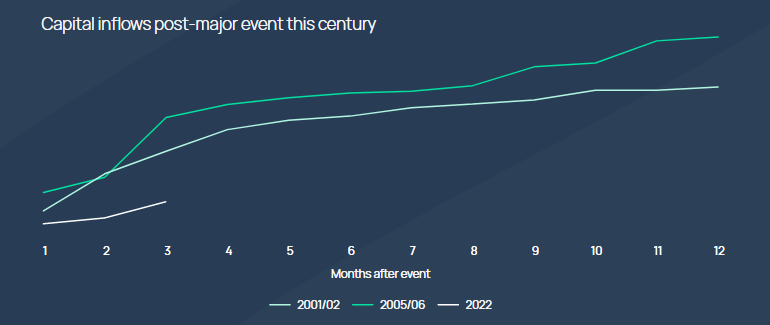
It also left certain reinsurers more exposed to liquidity and credit risks at a time of heightened claims uncertainty.
The reinsurance sector has reached concurrent secular and cyclical tipping points. It is experiencing sustained, heightened loss activity and war risk just as the global economy exits the ‘great moderation’ of interest rates and asset price volatility.
David Flandro, Head of Analytics, Howden
Pursuant increases in carrier costs of capital are underpinning higher rates-on-line, lower capacity levels, and straitened terms and conditions.
Components of capital decline for Howden’s reinsurance composite – YE21 to 3Q22
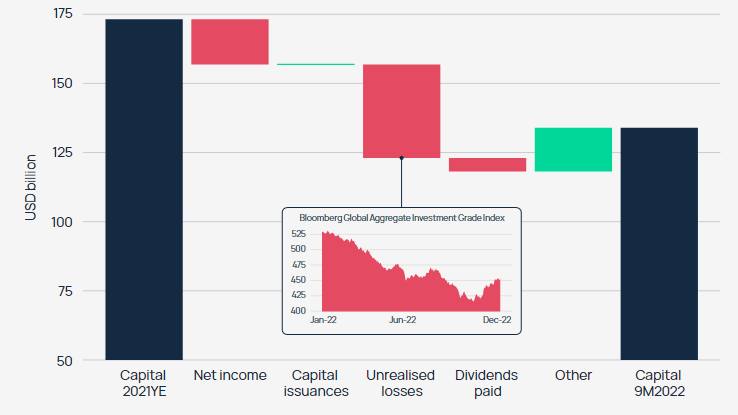
The last time we saw this level of capital dislocation was during the 2008-2009 global financial crisis. At the same time, the sector is experiencing its most acute, cyclical price increases since the 2001-2006 period if not before.
Dedicated reinsurance capital and global gross reinsurance premiums (all lines) – 2000 to 2022
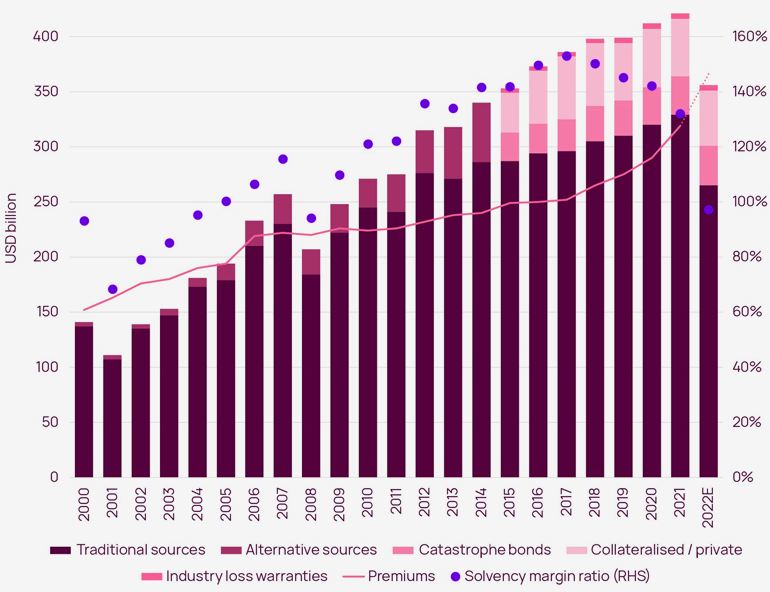
Global commercial insurance Market
Prices across most commercial insurance lines continued to rise in 2022, the fifth year of a hardening market cycle. Buyers’ hopes for a return to softer conditions have been complicated by multi-decadal inflation highs and sizeable losses from Hurricane Ian.
The commercial pricing cycle began in 2018 with diminished underwriting appetite, itself a reaction to weak results and earnings volatility.
Returns have improved significantly since despite exceptional market losses so far this decade, and impairments to sector capital in 2022.
Global commercial insurance pricing index – 2003 to 2022
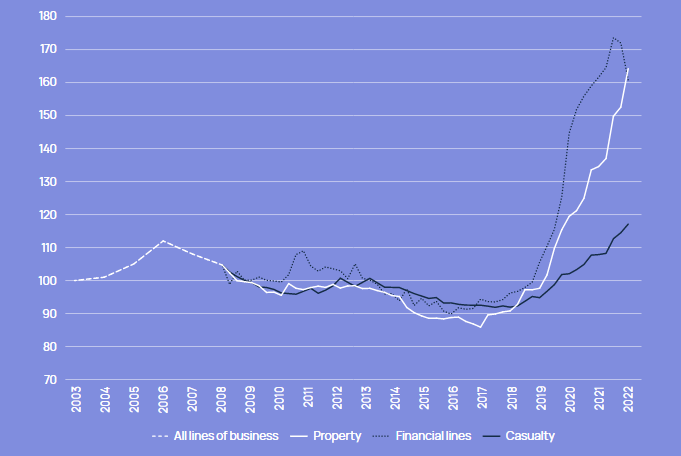
Although pricing continues to rise on an indexed basis overall, annual increases have begun to diminish. Commercial insurance rate rises averaged 9.8% year-on-year during the first three quarters of 2022, a deceleration from the 12.5% recorded for full-year 2021.
Most areas continued to achieve rate-on-rate gains in 2022, with some lines even bucking the tapering trend to record accelerated increases.
Strong competition in financial lines on the other hand saw pricing moderate initially and then decrease towards the end of the year. Classes with the highest price rises included cyber and catastrophe-exposed property whilst premiums for worker’s compensation and directors and officers (D&O) were subject to less pressure and registered decreases in certain regions (see Top 5 Risk Trends D&O Insurance Market).
The hard reinsurance market and higher financing costs, not to mention an unbroken six-year run of above-average catastrophe losses, mean insurers’ costs of capital are increasing.
Buyers can expect similarly bifurcated dynamics in 2023, with pockets of stress in areas such as property and other markets affected by adverse loss experience and rising claims inflation contrasting with capacity abundance elsewhere as insurers look to grow in lines where performance is strong.
The hard reinsurance market and higher financing costs, not to mention an unbroken six-year run of above-average catastrophe losses, mean insurers’ costs of capital are increasing.
The commercial market is well placed to navigate this environment. The underwriting uplift from 20 consecutive quarters of price increases is substantial and the delta between price and loss costs across commercial portfolios remains in insurers’ favour. Demand for protection continues to be robust, and crucially, higher investment returns will boost earnings as interest rates normalise.
Global non-life insurance premium – 2000 to 2022
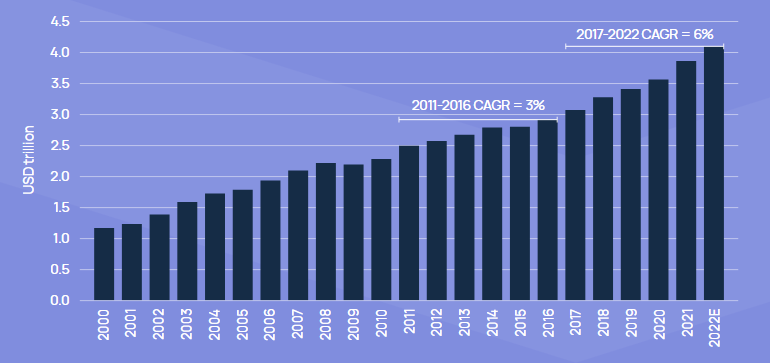
The viability of additional hardening must be weighed against the danger of businesses buying less protection and retaining more risk following four years of compounded rate increases and additional cost pressures elsewhere, not least energy.
The intricacies of the current marketplace require the highest level of broking experience and expertise to unlock supply.
For all the challenges confronting commercial insurance buyers, capacity is available as more carriers pivot from remediation to growth. These are disciplined plays designed to leverage the firming rate environment, and competition creates opportunity.
As the risk landscape undergoes structural change, and inflation requires careful adjustments to limits to address higher insured values, differentiated advice and creative risk management solutions can make all the difference.
Headline inflation forecasts in advanced economies – 1Q20 to 4Q23

1 January 2023 reinsurance renewals
All of this has converged to create highly challenged and complex reinsurance renewals at 1 January 2023. Structures and coverage terms were at the forefront of property-catastrophe negotiations this year, amidst recognition from all parties that prices would rise significantly.
Reissued firm order terms, non-concurrent terms and diversification plays leveraging demand for catastrophe capacity as a way to improve access and margins for non-property business reflected shifting market conditions.
Direct and Facultative Reinsurance
Even in this highly challenged environment, the direct and facultative (D&F) market recorded strong growth in 2022 and continued to support clients renewing programmes at 1 January 2023. Increased demand for D&F catastrophe cover – driven by an inflation-induced rise in insured valuations on original business, attendant requirements for increased reinsurance limits and reduced retrocession capacity – added to pre-existing supply and pricing pressures.
Six successive years of significant D&F rate rises, with a marked acceleration of 45%2 in 2023, has yielded a cumulative increase of 160% plus since 2017 to take pricing levels above those recorded in the aftermath of Hurricane Katrina in 2006.
The underlying market has benefitted from even more substantial pricing tailwinds during this time.
The D&F market at 1 January 2023 was resilient given the challenging backdrop to renewals. Capacity continued to be available at the right price and right level, which meant most placements were completed by year-end. This is testament to the D&F market once again differentiating itself by finding capacity for increased business flow whilst displaying underwriting skill and delivering strong results.
Investment in talent is essential to deliver the joined-up service clients expect in the current market cycle.
Bradley Maltese, CEO, Howden RE
Howden has made it a priority to ensure we have the best possible teams in place – teams that blend youth and innovation with seniority and experience – and with the imminent union between Howden RE and TigerRisk we look forward to raising the bar further in 2023.
Retrocession
Hurricane Ian’s impact on an already dislocated retrocession market meant a sizeable portion of collateralised retrocession capital was trapped going into 1 January 2023 renewals.
Risk-adjusted retrocession catastrophe excess-of-loss rates-on-line rose by 50% on average at 1 January 2023, with a range of up 20% to up 90%.
Following significant remediation to aggregate covers and low-attaching occurrence layers at previous renewals, double-digit increases were also recorded for layers further up occurrence programmes at 1 January 2023, indicative of the acute supply constraints across the market.
Howden Risk-Adjusted Non-marine Retrocession Catastrophe Rate-on-Line Index – 1992 to 2023
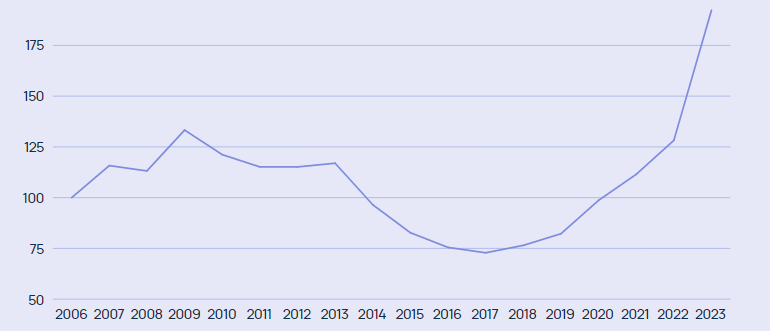
Some capital providers looked for allocation opportunities in the run-up to renewal, but not at a level or commitment sufficient to ease supply gaps. Trapped capital from Hurricane Ian, alongside downsized allocation limits due to poor performance in equity and bond markets, led to reduced capital inflows into the catastrophe bond market.
As a result, new issuances fell, spreads widened significantly, transaction sizes shrunk and terms tightened in 4Q22.
Pricing widened throughout the curve, up approximately 50% versus the first half of 2022 and between 70% and 120% compared to 2021 levels.
The catastrophe bond market nevertheless continues to be the preferred ILS product due to the liquidity provided to investors, as evidenced by eleven transactions in Q4, raising approximately USD 1.5 billion in capital markets-based risk transfer capacity.
Activity in the insurance loss warranty (ILW) market increased as cedents looked to secure capacity despite historically high pricing (up 70% on average in December for U.S. wind and earthquake) and higher attachment triggers (most trades were above USD 60 billion)
Property Cat Reinsurance
Late or incomplete retrocession placements meant that property-catastrophe reinsurers had less clarity than usual around their net positions when offering renewal lines at 1 January 2023. Howden’s Global Property-Catastrophe Risk-Adjusted Rate-on-Line Index rose by an average of 37% at 1 January 2023. This was considerably higher than the 9% recorded last year, and marks the biggest year-on-year increase since 1992.
Howden Global Risk-Adjusted Property-Catastrophe Rate-on-Line Index – 1992 to 2023

Following on storm Bernd in 2021, the European market suffered further damaging catastrophe losses in 2022, including costly EU windstorms early in the year and historic hail events in France during the summer (see Global Natural Catastrophe & Hazard Review).
Strong demand for additional limits to counter inflation, combined with some retrenchment from incumbent reinsurers, created a challenging environment for buyers that often resulted in higher attachment points, more stringent terms, paid reinstatements and substantial rate increases – up 30% on average, but significantly higher for loss-affected programmes.
Capacity was nevertheless sufficient to see most deals over the line, particularly for cedents able to demonstrate strong performance and / or leverage long-standing relationships.
U.S. GDP vs P&C insurance premiums – 1998 to 2022
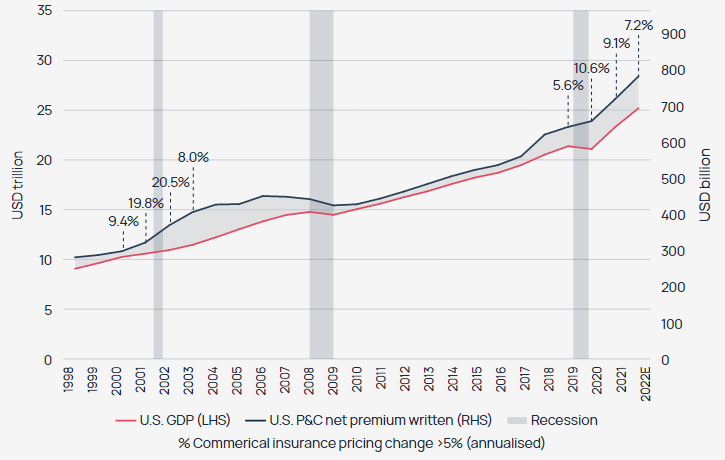
Renewals were more challenged in the United States, with an average rate-on-line increase of 50% reflecting a highly stressed marketplace that became even more so after Hurricane Ian’s historic loss.
Global insured catastrophe losses by quarter – 2012 to 2022
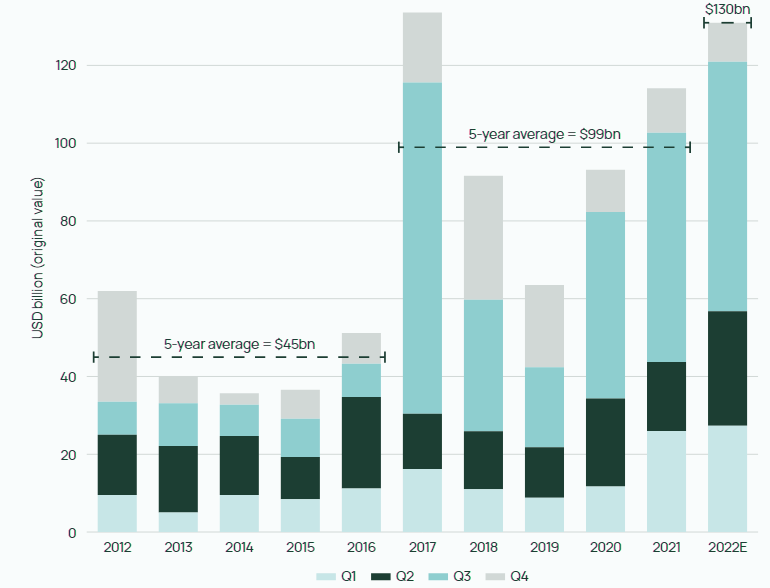
From a pricing perspective, this typically translated into mid double-digit increases depending on performance and loss experience. Equally consequential changes were made to terms and conditions, event definitions and scope of coverage as reinsurers looked to reduce earnings volatility following the unusual mix of major losses. Where reinsurers’ demands were not met, participations were often reduced and some layers went unfilled.
Increased demand coincided with supply constraints to create the most difficult U.S. renewal in decades. Some buyers failed to fill their programmes and named-peril coverage was more prevalent. Certain insurers resorted to shortfall covers as a result. The result was the biggest change in rates-on-line since 2006. The lack of capacity for lower layers meant cedents were forced to retain more.
Casualty Reinsurance
Casualty reinsurance supply dynamics, facilitated by reinsurers’ diversification strategies, remained stable throughout 2022 and into the 1 January 2023 renewal.
Reinsurers in the casualty space have benefitted from a prolonged period of compounded price increases on original business, even if these moderated last year. Investment portfolios will also soon yield improved returns as interest rates rises.
Casualty renewals nevertheless tightened at 1 January 2023. London market casualty excess-of-loss reinsurance, including adjustments for exposure changes and the inflationary impact, rose by 5% on average at 1 January 2023.
Howden London Market Casualty Risk-Adjusted Reinsurance Rate Index – 1992 to 2023
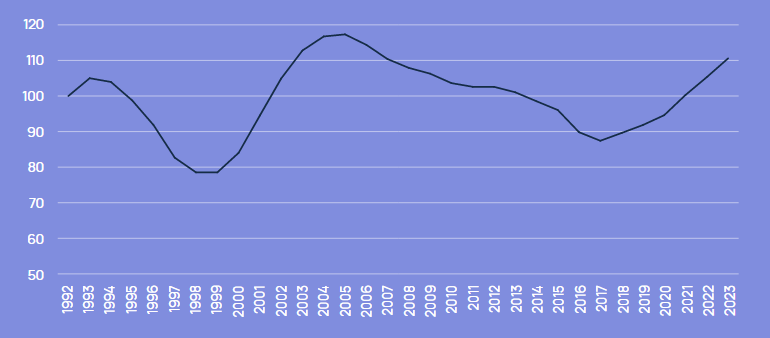
Reinsurers cited rising inflation and the prospect of higher claims severity for the increases. Outcomes were similar to those recorded last year (where the corresponding data point was + 5%), as strong demand and discerning supply told.
Annualised change to incurred losses for select U.S. long-tail lines – 2010 to 2021
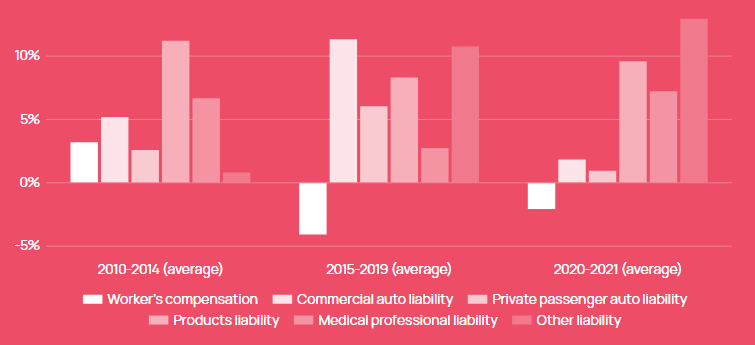
2020 saw a sharp reduction in long-tail claims frequency because of COVID, with significant falls in incurred losses across the board,4 only for a near-full reversal last year to leave 2020-21 averages closer to pre-pandemic levels. Results for worker’s compensation continue to be positive, assisted by favourable claims experience and changing workers patterns.
Reinsurance Outlook for 2023
The world has become a riskier place. The effects of COVID – huge fiscal and monetary stimulus, supply constraints and high debt burdens – have collided with the devastating fallout from Russia’s invasion of Ukraine to bring about a great realignment, characterised by structurally higher inflation, rising interest rates, increased recessionary risk, heightened security threats and accelerated deglobalisation.
U.S. CPI for categories relevant to short-tail and liability lines vs year-on-year price changes – 1Q20 to 4Q22
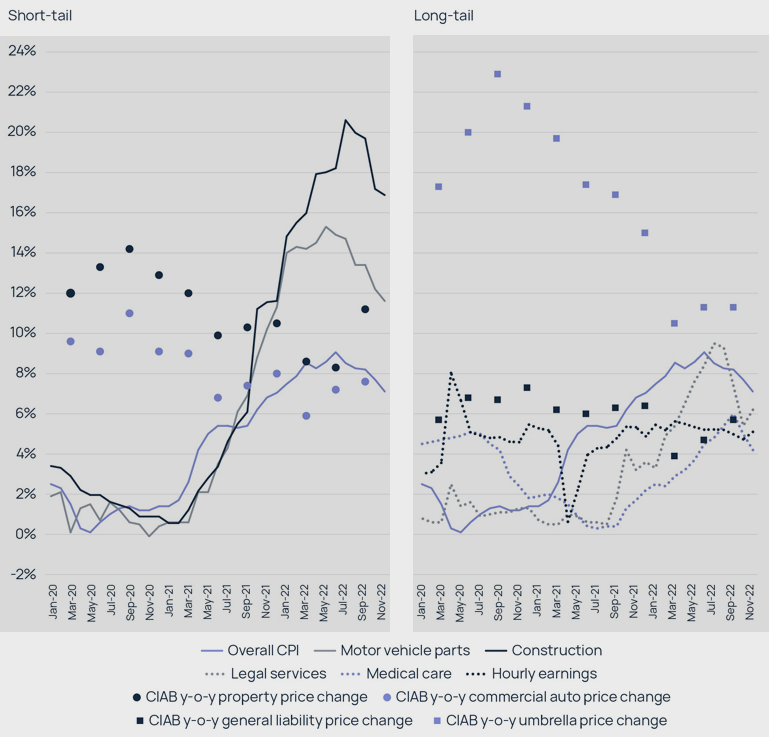
This backdrop has important implications for the (re)insurance market. How inflation develops over the next year or two will be a key input into demand and loss cost inflation. Figure shows that short-tail lines such as property and motor have been most impacted by surging inflation in 2022.
Long-tail lines have been less impacted so far, although reserving adequacy will come under close scrutiny in 2023 should inflation penetrate into sticker parts of economies and become entrenched.
Announced capital inflows leading up to 1 January renewals – 2022 vs 2005 and 2001
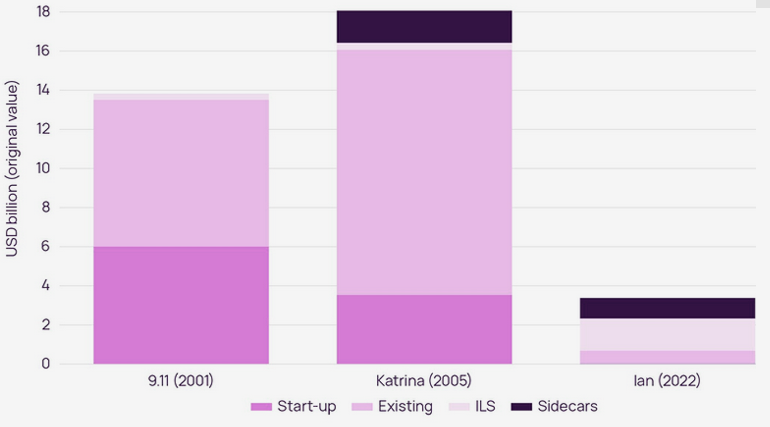
Macroeconomics are also crucial to capital inflows. The (re)insurance sector has previously attracted substantial amounts of capital post-shock events to compensate for the loss of capacity and leverage the attendant pricing opportunities.
Although inflows slowed significantly last year, especially compared to previous large loss years, strong potential returns on offer in 2023 could soon entice capital back into the market.
Unlocking capacity in order to find solutions for rapidly changing risks that may soon outgrow the sector’s capital base will be crucial to maintaining relevance and offering clients coverage that meets their needs.
This is especially true for 2023, given the considerable macroeconomic and sector.
……………..
AUTHORS: Julian Alovisi – Head of Research Howden, David Flandro – Head of Analytics Howden, Michelle To – Head of Business Intelligence – Executive Director at Howden Tiger
Fact checked by Oleg Parashchak








